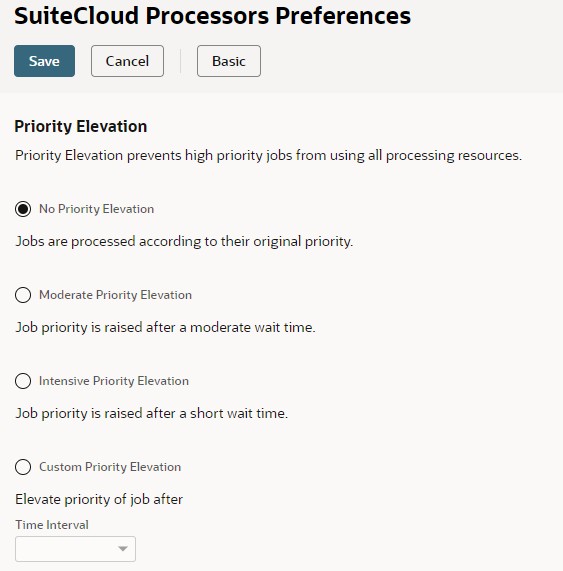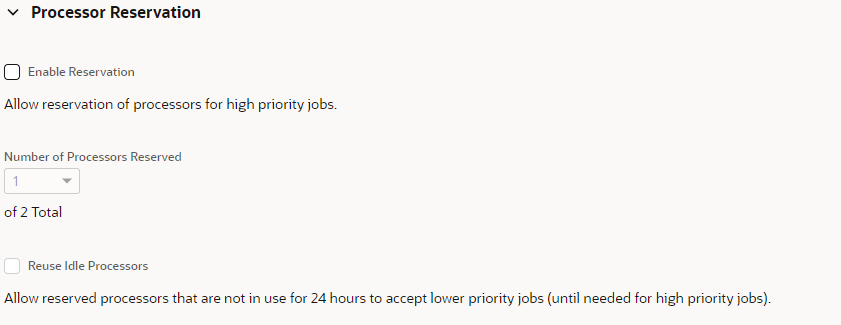SuiteCloud Processors Priority Elevation and Processor Reservation (Advanced Settings)
Priority Elevation
Priority elevation lets you to automatically raise the priority of each low or standard priority job after a specific amount of time. The time interval starts when the job is submitted. You usually don't need to use these settings so priority elevation is disabled by default. However, you may need to use them if lower priority jobs experience excessive wait times.
Priority elevation only affects lower priority jobs with a wait time greater than the time interval indicated. If a lower priority job is sent to the processor pool before the time interval ends, it is processed with its original priority.
To access the priority elevation settings, go to Setup > Preferences > SuiteCloud Processors.

There are three settings:
-
No Priority Elevation: The default setting.
-
Moderate Priority Elevation:
-
If a low priority job is still waiting after four hours, it's elevated to standard priority.
-
If a standard priority job is still waiting after four hours, it's elevated to high priority.
With this option, if priority elevation applies, the system elevates low priority jobs to high priority jobs after eight hours. Specifically, these jobs are elevated to standard priority after four hours and to high priority after another four hours.
-
-
Intensive Priority Elevation:
-
If a low priority job is still waiting after one hour, it's elevated to standard priority.
-
If a standard priority job is still waiting after one hour, it's elevated to high priority.
With this option, if priority elevation applies, the system elevates low priority jobs to high priority jobs after two hours. Specifically, these jobs are elevated to standard priority after one hour and to high priority after another hour.
-
-
Custom Priority Elevation: This option lets you to specify a custom time interval for priority elevation using the Time Interval field.
The Time Interval field shows the time interval set for priority elevation. When you select Custom Priority Elevation, you can edit the field. Otherwise, the field shows a value that corresponds to the option selected, but you can't edit it..
Click Advanced at the top of the page to access Custom Priority Elevation and Time Interval.
Processor Reservation
Processor reservation lets you to reserve processors for high priority jobs. You usually don't need to use these settings so processor reservation is disabled by default.
Processor reservation is only available for SuiteCloud Plus accounts.
To access the priority reservation settings, go to Setup > Preferences > SuiteCloud Processors. Click Advanced at the top of the page.

When you select Enable Reservation, you can reserve all but one of your available processors from the Number of Processors Reserved list. If a high priority job is submitted, it's sent to the processor pool if there's at least one processor available. If a standard or low priority job is submitted, it's sent to the processor pool only if there are more processors available than the number reserved. For example, let's say you have 10 processors reserved out of 25 total processors. A standard or low priority job is sent to the processor pool if there are at least 11 processors available. If there are 10 processors or fewer available, the lower priority job has to wait.
Changes to the Number of Processors Reserved apply to all jobs that haven't yet started. This can have immediate affect map/reduce scripts, since each stage is processed by at least one job. If a high priority map/reduce script task is executing and you change the setting, the new value applies to all jobs for the tasks that haven't started yet. This includes jobs created from yielding.
Processor reservation reduces the number of processors available for standard and low priority jobs. So, it can reduce the throughput of these jobs. The Reuse Idle Processors setting temporarily releases reserved processors that haven't been used in the past 24 hours. This increases the number of processors available for lower priority jobs.
When Reuse Idle Processors is enabled, it starts an hourly recurring audit. The system uses the data collected to determine whether to release reserved processors. After reserved processors are released, the system checks the audit data to decide if it needs to increase reserved processors.
If the system decreases or increases the number of reserved processors, additional decreases aren't made for 24 hours. However, additional increases (up to the selected limit) can still be made after each hourly audit. This process continues if Reuse Idle Processors is enabled.
The system analyzes the following data points during this process:
-
a = total number of processors available
-
b = the value you set for Number of Processors Reserved (the maximum number of reserved processors; this number doesn't change)
-
c = maximum number of jobs concurrently processed in the last 24 hours
-
d = maximum number of high priority jobs that concurrently waited more than a minute in the last hour
-
e = current number of reserved processors (this number can change if Reuse Idle Processors is enabled)
|
If |
Then |
|---|---|
|
c is less than a This means that some reserved processors weren't used. |
The number of processors available to lower priority jobs is increased by a – c (up to the value of a). |
|
e is less than b AND d is more than 0 |
The number of reserved processors is increased by d (up to the value of b) The system can't increase the number of reserved processors over the limit set for Number of Processors Reserved. In other words, e can't be greater than b. |